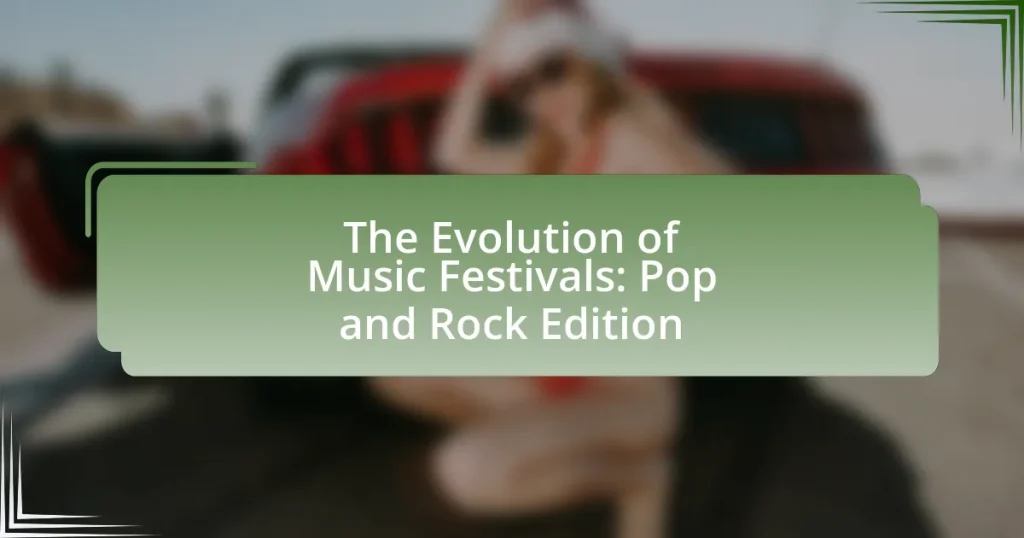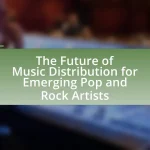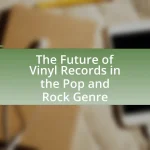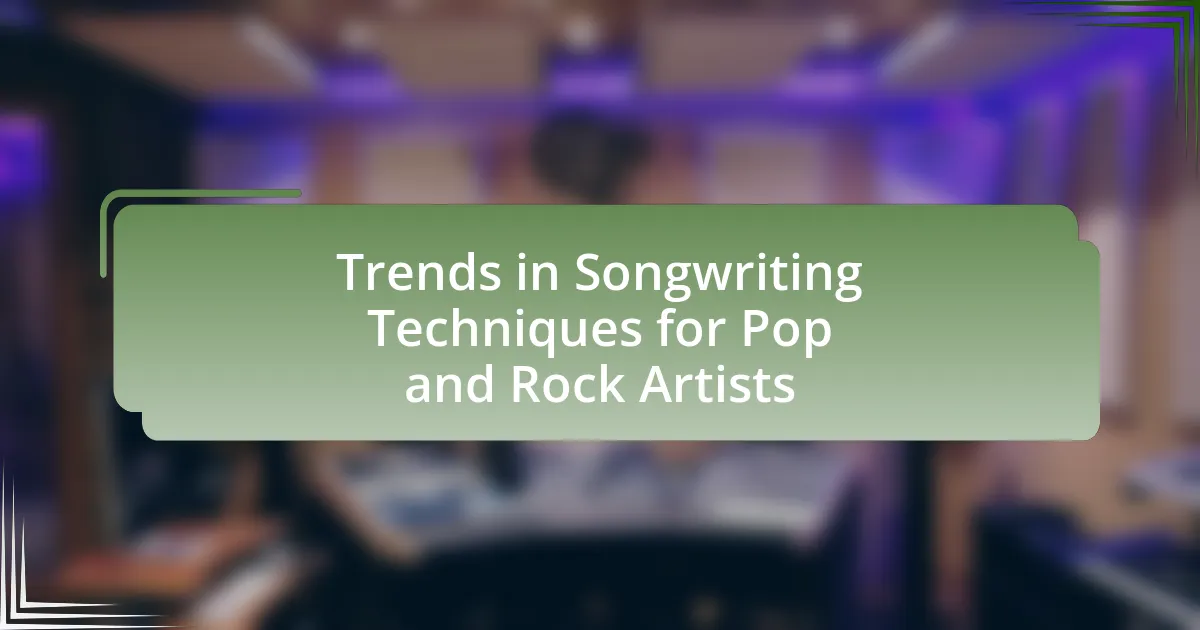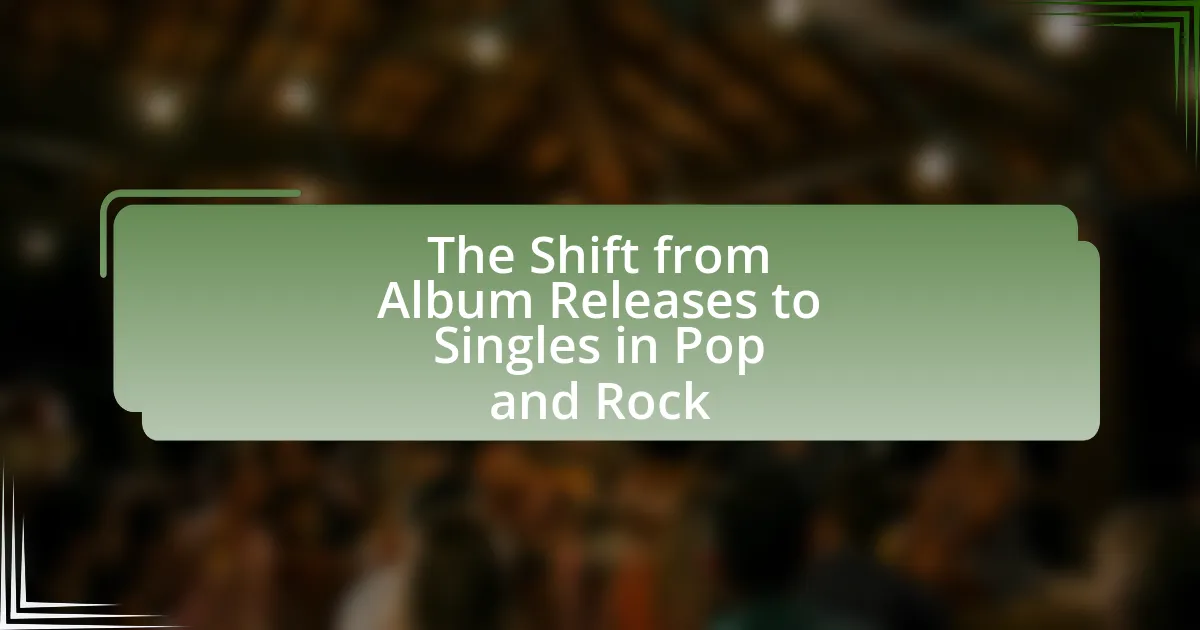The article “The Evolution of Music Festivals: Pop and Rock Edition” examines the historical development and cultural significance of music festivals in the pop and rock genres, tracing their origins back to the 1960s with landmark events like the Monterey Pop Festival and Woodstock. It highlights how early festivals shaped the music landscape by promoting emerging artists and fostering community, while also addressing the influence of cultural movements on festival themes. The article discusses the evolution of festival structures, the impact of technology, and current trends such as sustainability and inclusivity, as well as the challenges faced by festivals today, including financial sustainability and safety concerns. Additionally, it explores the future of music festivals, emphasizing innovations in audience engagement and the integration of new genres and artists.
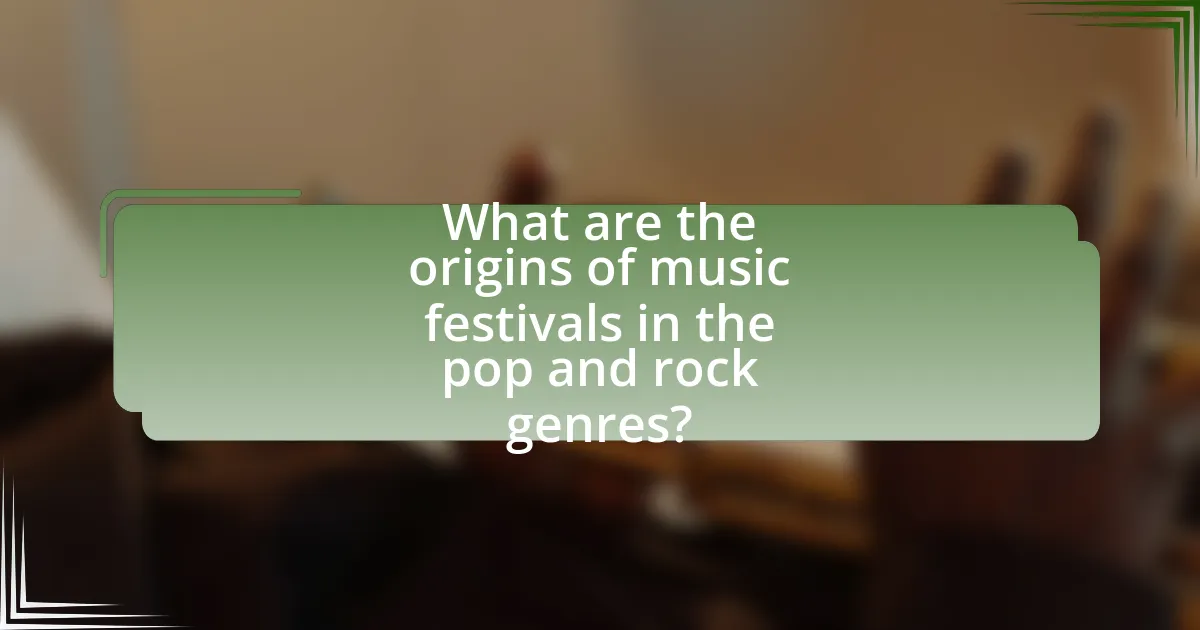
What are the origins of music festivals in the pop and rock genres?
The origins of music festivals in the pop and rock genres can be traced back to the 1960s, particularly with the emergence of large-scale events like the Monterey Pop Festival in 1967 and Woodstock in 1969. These festivals marked a significant cultural shift, bringing together diverse audiences to celebrate music and counterculture. The Monterey Pop Festival is often credited as the first major rock festival, showcasing artists such as Jimi Hendrix and Janis Joplin, while Woodstock became a symbol of the 1960s counterculture movement, attracting over 400,000 attendees and featuring performances from iconic artists like Bob Dylan and The Who. These events laid the groundwork for the modern music festival landscape, influencing the organization and promotion of future festivals in the pop and rock genres.
How did early music festivals shape the landscape of pop and rock music?
Early music festivals significantly shaped the landscape of pop and rock music by providing a platform for emerging artists and fostering a sense of community among fans. Events like the Monterey Pop Festival in 1967 and Woodstock in 1969 showcased a diverse array of musical talent, introducing audiences to new genres and styles. These festivals not only elevated the visibility of artists such as Jimi Hendrix and Janis Joplin but also influenced the cultural and social movements of the time, promoting ideals of peace, love, and counterculture. The success of these festivals demonstrated the commercial viability of large-scale music events, leading to the establishment of annual festivals that continue to impact the music industry today.
What were the key events that marked the beginning of music festivals?
The key events that marked the beginning of music festivals include the Newport Jazz Festival in 1954 and the Monterey Pop Festival in 1967. The Newport Jazz Festival is recognized as one of the first major music festivals, showcasing prominent jazz artists and setting a precedent for future events. The Monterey Pop Festival is significant for introducing the concept of a multi-genre festival, featuring rock, pop, and folk artists, and is often credited with launching the modern music festival movement. These events laid the groundwork for the evolution of music festivals, influencing the structure and culture of subsequent festivals worldwide.
How did cultural movements influence the emergence of these festivals?
Cultural movements significantly influenced the emergence of music festivals by providing a platform for artistic expression and community engagement. The counterculture movement of the 1960s, for example, led to the establishment of iconic festivals like Woodstock in 1969, which celebrated peace, love, and music, reflecting the social and political upheaval of the time. Additionally, the punk rock movement in the 1970s fostered festivals that emphasized DIY ethics and anti-establishment sentiments, such as the Reading Festival in the UK. These cultural movements not only shaped the themes and values of the festivals but also attracted diverse audiences, creating a lasting impact on the music festival landscape.
What role did iconic festivals play in the evolution of music?
Iconic festivals have significantly influenced the evolution of music by serving as platforms for genre innovation, cultural exchange, and artist exposure. For instance, the Woodstock Festival in 1969 not only popularized the counterculture movement but also showcased emerging rock and folk artists, leading to the mainstream acceptance of these genres. Similarly, the Glastonbury Festival has been pivotal in promoting diverse musical styles, from electronic to world music, thereby shaping the musical landscape. These festivals have also facilitated collaborations among artists, fostering creativity and experimentation, which has been essential for the progression of music. The historical impact of these events is evident in how they have transformed music consumption and community engagement, making them crucial to the music industry’s evolution.
Which festivals became pivotal in defining pop and rock music trends?
The festivals that became pivotal in defining pop and rock music trends include Woodstock, Glastonbury, and Coachella. Woodstock, held in 1969, symbolized the counterculture movement and featured iconic performances from artists like Jimi Hendrix and Janis Joplin, influencing the music landscape significantly. Glastonbury, established in 1970, has showcased a diverse range of artists and genres, becoming a benchmark for festival culture and artist exposure. Coachella, launched in 1999, has set trends in music and fashion, attracting major headliners and shaping the festival experience with its innovative production and branding. Each of these festivals has played a crucial role in shaping the evolution of pop and rock music, reflecting and influencing cultural shifts over the decades.
How did the lineup of these festivals reflect the musical tastes of their time?
The lineup of music festivals reflected the musical tastes of their time by showcasing the most popular and influential artists of specific eras. For instance, the Woodstock Festival in 1969 featured iconic acts like Jimi Hendrix and Janis Joplin, representing the counterculture movement and the rise of rock music, which resonated with the youth’s desire for social change and artistic expression. Similarly, the emergence of Coachella in the late 1990s highlighted a blend of genres, including alternative rock and electronic music, mirroring the eclectic tastes of a generation that embraced diversity in sound. These lineups not only catered to prevailing trends but also influenced the direction of music, as seen in the rise of genres like grunge in the early 1990s, represented by bands like Nirvana at festivals. Thus, the selection of artists at these festivals serves as a barometer for the evolving musical landscape and cultural sentiments of their respective periods.
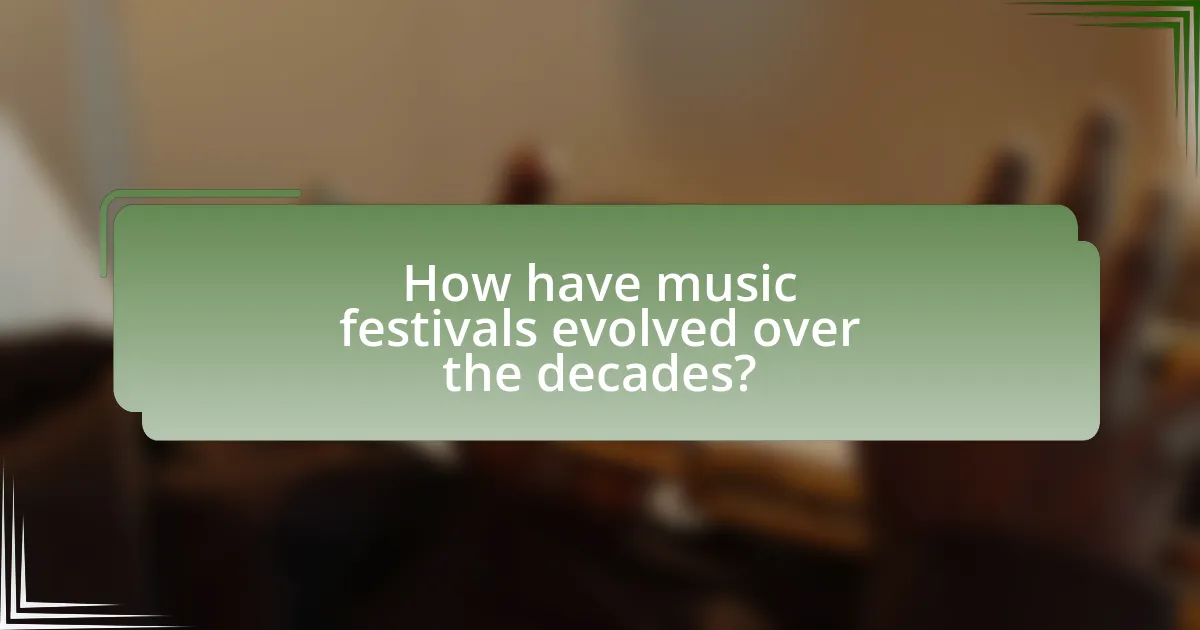
How have music festivals evolved over the decades?
Music festivals have evolved significantly over the decades, transitioning from small, localized gatherings to large-scale, commercially-driven events. In the 1960s, festivals like Woodstock introduced the concept of mass gatherings centered around music, emphasizing counterculture and community. By the 1980s and 1990s, festivals began to diversify, with events like Lollapalooza and Glastonbury showcasing a wider range of genres and attracting larger audiences, often featuring multiple stages and a variety of activities beyond music.
In the 2000s, the rise of digital technology and social media transformed festival promotion and audience engagement, allowing for real-time interaction and broader reach. Festivals now often incorporate elaborate production elements, including advanced sound systems, light shows, and immersive experiences, catering to a more diverse demographic. The global festival scene has also expanded, with events like Coachella and Tomorrowland becoming international phenomena, drawing attendees from around the world and generating significant economic impact.
Overall, the evolution of music festivals reflects broader cultural shifts, technological advancements, and changing audience expectations, marking a shift from grassroots origins to a multi-billion dollar industry.
What changes have occurred in the structure and organization of music festivals?
Music festivals have undergone significant changes in their structure and organization, primarily shifting towards more diverse programming, enhanced logistical planning, and increased emphasis on sustainability. The introduction of multi-genre lineups has broadened audience appeal, while advancements in technology have streamlined ticketing and scheduling processes. Additionally, many festivals now incorporate eco-friendly practices, such as waste reduction and renewable energy use, reflecting a growing awareness of environmental impact. For instance, events like Coachella and Glastonbury have implemented extensive recycling programs and carbon offset initiatives, showcasing a commitment to sustainability in the festival landscape.
How has technology impacted the way festivals are produced and experienced?
Technology has significantly transformed the production and experience of festivals by enhancing logistics, improving audience engagement, and enabling innovative performances. For instance, advancements in sound and lighting technology allow for more immersive experiences, with high-definition visuals and superior audio quality that elevate the overall atmosphere. Additionally, the use of social media platforms facilitates real-time interaction between artists and attendees, fostering a sense of community and increasing event visibility. Data analytics tools enable organizers to optimize scheduling and resource allocation, leading to more efficient operations. According to a report by Eventbrite, 70% of festival-goers engage with events through social media, highlighting the importance of technology in shaping modern festival experiences.
What are the trends in festival attendance and demographics over the years?
Festival attendance has generally increased over the years, with significant growth noted in the 2000s and 2010s, driven by the rise of social media and digital marketing. For example, Coachella’s attendance surged from 40,000 in 1999 to over 250,000 in 2019, reflecting a broader trend of larger crowds at major music festivals. Demographically, festivals have seen a diversification in attendees, with younger audiences, particularly millennials and Gen Z, making up a larger portion of the crowd. According to a 2020 report by the Eventbrite, 78% of festival-goers are under 34 years old, indicating a shift towards a younger demographic. Additionally, there has been an increase in female attendance, with many festivals actively promoting gender diversity in lineups. This evolution in both attendance numbers and demographics highlights the changing landscape of music festivals over the years.
How have pop and rock music festivals adapted to societal changes?
Pop and rock music festivals have adapted to societal changes by incorporating diverse lineups, enhancing accessibility, and prioritizing sustainability. Festivals now feature a wider range of genres and artists to reflect the growing demand for inclusivity and representation, as seen in events like Coachella and Glastonbury, which showcase artists from various backgrounds. Additionally, many festivals have implemented measures to improve accessibility for individuals with disabilities, ensuring that all attendees can participate fully. Furthermore, the rise of environmental awareness has led festivals to adopt sustainable practices, such as reducing waste and promoting eco-friendly initiatives, with events like Lollapalooza committing to carbon neutrality by 2023. These adaptations demonstrate the festivals’ responsiveness to evolving societal values and expectations.
What initiatives have festivals taken to promote inclusivity and diversity?
Festivals have implemented various initiatives to promote inclusivity and diversity, such as establishing diversity quotas for performers and creating safe spaces for marginalized groups. For example, many festivals now prioritize booking artists from underrepresented backgrounds, ensuring that lineups reflect a broader spectrum of cultural identities. Additionally, festivals have introduced accessibility measures, including wheelchair access and sensory-friendly environments, to accommodate attendees with disabilities. These initiatives are supported by research indicating that diverse representation enhances audience engagement and fosters a more inclusive atmosphere, as seen in studies conducted by organizations like the Music Industry Research Association.
How have environmental concerns influenced festival planning and execution?
Environmental concerns have significantly influenced festival planning and execution by prompting organizers to adopt sustainable practices. Many festivals now prioritize waste reduction, implementing recycling and composting programs to minimize landfill contributions. For instance, the Glastonbury Festival has committed to becoming a zero-waste event, aiming to recycle or compost 100% of its waste. Additionally, festivals are increasingly utilizing renewable energy sources, such as solar and wind power, to reduce their carbon footprint. The Coachella Valley Music and Arts Festival has incorporated solar panels to power stages and facilities, showcasing a commitment to sustainability. Furthermore, transportation strategies have evolved, with many festivals encouraging carpooling and providing shuttle services to reduce emissions. These initiatives reflect a broader trend in the music festival industry towards environmental responsibility, driven by both consumer demand and regulatory pressures.
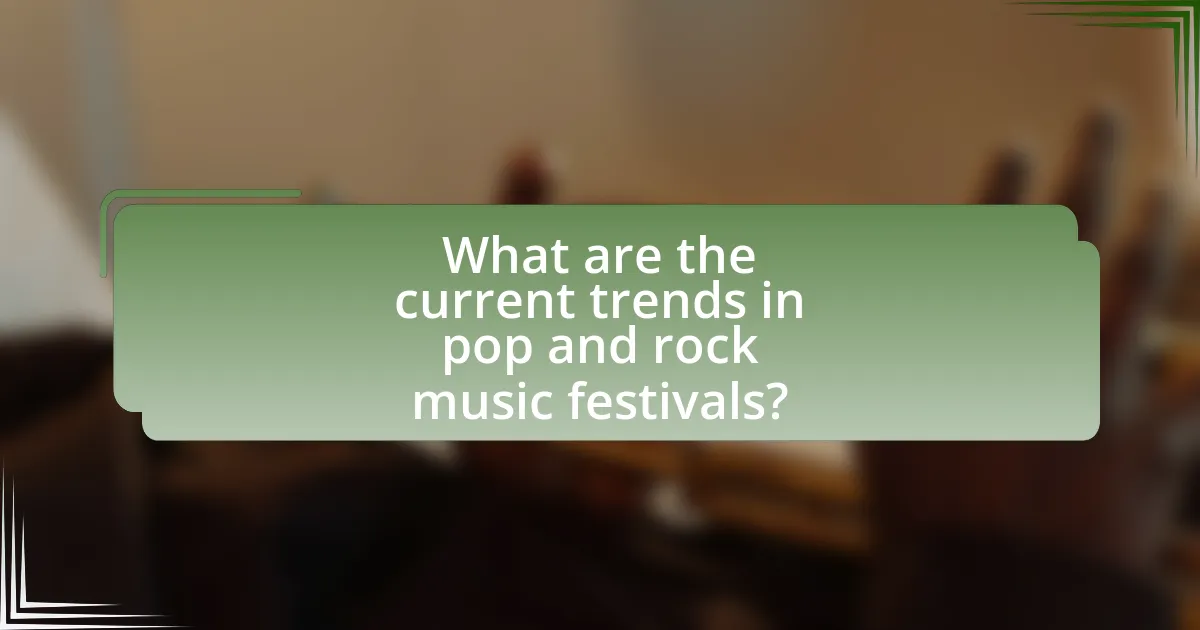
What are the current trends in pop and rock music festivals?
Current trends in pop and rock music festivals include a focus on sustainability, diverse lineups, and enhanced fan experiences. Festivals are increasingly adopting eco-friendly practices, such as reducing waste and using renewable energy sources, to address environmental concerns. For instance, events like Glastonbury have implemented measures to minimize plastic use and promote recycling. Additionally, there is a growing emphasis on inclusivity, with festivals featuring a wider range of artists from various backgrounds and genres, reflecting societal shifts towards diversity. Enhanced fan experiences are also a trend, with many festivals incorporating technology, such as cashless payment systems and interactive apps, to improve attendee engagement and convenience. These trends are reshaping the landscape of pop and rock music festivals, making them more relevant and appealing to modern audiences.
How are modern festivals incorporating new genres and artists?
Modern festivals are incorporating new genres and artists by diversifying their lineups to include a wider range of musical styles and emerging talent. This shift is evident in festivals like Coachella and Glastonbury, which now feature genres such as electronic dance music, hip-hop, and indie rock alongside traditional pop and rock acts. For instance, Coachella has showcased artists like Billie Eilish and Lil Nas X, who represent contemporary trends and appeal to younger audiences. Additionally, many festivals are implementing stages dedicated to niche genres, allowing for greater representation of underrepresented artists and styles. This approach not only attracts a broader audience but also fosters innovation within the music scene, as festivals adapt to changing musical landscapes and audience preferences.
What role do emerging artists play in contemporary music festivals?
Emerging artists play a crucial role in contemporary music festivals by introducing fresh sounds and diverse perspectives to the music scene. These artists often serve as a bridge between established acts and new audiences, helping to cultivate a vibrant and dynamic festival atmosphere. For instance, festivals like Coachella and Glastonbury have dedicated stages for emerging talent, showcasing over 100 new artists each year, which not only enhances the festival experience but also provides these artists with significant exposure and opportunities for growth. This practice supports the music industry’s ecosystem by fostering innovation and encouraging the discovery of new genres and styles.
How are festivals using social media to enhance audience engagement?
Festivals are using social media to enhance audience engagement by creating interactive content and fostering real-time communication. This approach allows festivals to share live updates, behind-the-scenes footage, and user-generated content, which increases audience participation and excitement. For example, festivals like Coachella and Glastonbury utilize platforms such as Instagram and Twitter to engage attendees through polls, contests, and hashtags, encouraging fans to share their experiences. Research indicates that 79% of festival-goers are influenced by social media when deciding to attend an event, highlighting its effectiveness in driving engagement and ticket sales.
What challenges do music festivals face today?
Music festivals today face significant challenges including financial sustainability, safety and security concerns, and environmental impact. Financial sustainability is a pressing issue as rising costs for artists, production, and logistics often outpace ticket sales, leading to potential losses; for instance, a 2022 report indicated that 40% of festivals operated at a loss. Safety and security concerns have intensified due to incidents of violence and health crises, such as the COVID-19 pandemic, which forced many festivals to cancel or postpone events, impacting attendance and revenue. Additionally, environmental impact has become a critical challenge, with festivals contributing to waste and carbon emissions; a study found that large festivals can generate over 1,000 tons of waste, prompting calls for more sustainable practices.
How has the COVID-19 pandemic affected the festival landscape?
The COVID-19 pandemic has significantly disrupted the festival landscape by leading to widespread cancellations and postponements of events. In 2020, over 90% of music festivals were either canceled or rescheduled, resulting in substantial financial losses for organizers and artists alike. Additionally, the pandemic prompted a shift towards virtual events, with many festivals adopting online formats to reach audiences, exemplified by events like the virtual Coachella in 2020. This transition highlighted the importance of digital engagement in the festival experience, altering how festivals are planned and executed in the future.
What are the financial implications for festivals in the current climate?
The financial implications for festivals in the current climate include increased operational costs, reduced attendance, and heightened uncertainty regarding sponsorship and ticket sales. Festivals are facing rising expenses due to inflation, supply chain disruptions, and enhanced health and safety measures, which can lead to budget overruns. For instance, a report from the National Independent Venue Association indicates that 90% of independent venues and festivals are struggling financially, with many unable to cover their costs without government assistance. Additionally, consumer behavior has shifted, with many potential attendees hesitant to commit to large gatherings, resulting in lower ticket sales and revenue. This combination of factors creates a challenging financial landscape for festivals, necessitating strategic adjustments to ensure sustainability.
What can attendees expect from the future of pop and rock music festivals?
Attendees can expect increased integration of technology and immersive experiences at future pop and rock music festivals. This evolution includes the use of augmented reality (AR) and virtual reality (VR) to enhance live performances, allowing fans to engage with artists and the festival environment in new ways. For instance, festivals like Coachella have already begun experimenting with AR features, providing interactive experiences that blend the physical and digital realms. Additionally, sustainability initiatives are becoming a priority, with many festivals committing to eco-friendly practices, such as reducing waste and promoting renewable energy sources. According to a report by the International Music Summit, 70% of festival organizers are prioritizing sustainability in their planning, reflecting a growing trend towards environmentally conscious events.
What innovations are on the horizon for festival experiences?
Innovations on the horizon for festival experiences include the integration of augmented reality (AR) and virtual reality (VR) technologies, which enhance audience engagement by providing immersive experiences. For instance, festivals are exploring AR applications that allow attendees to interact with digital elements in real-time, such as virtual art installations or interactive performances. Additionally, advancements in cashless payment systems and mobile applications are streamlining transactions and improving convenience for festival-goers. According to a report by Eventbrite, 75% of festival organizers are investing in technology to enhance attendee experiences, indicating a strong trend towards tech-driven innovations in the festival landscape.
How can festival-goers prepare for the evolving landscape of music festivals?
Festival-goers can prepare for the evolving landscape of music festivals by staying informed about changes in festival formats, lineups, and health protocols. As music festivals increasingly incorporate technology, such as virtual experiences and cashless transactions, attendees should familiarize themselves with these innovations to enhance their experience. Additionally, understanding the impact of social media on festival culture can help festival-goers connect with artists and fellow attendees, ensuring they remain engaged and informed. The rise of hybrid festivals, which combine in-person and online elements, further emphasizes the need for adaptability and openness to new experiences in the festival environment.
